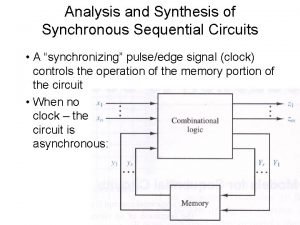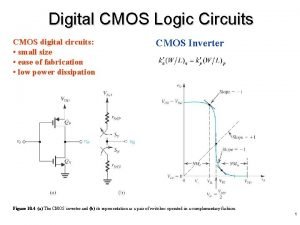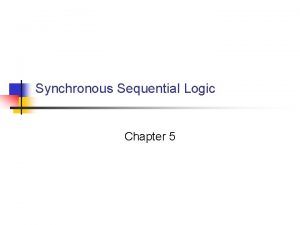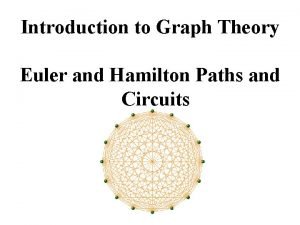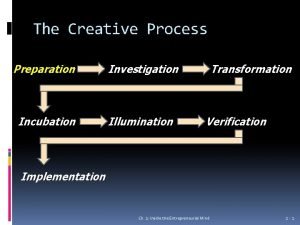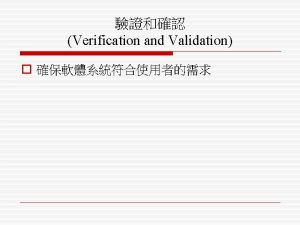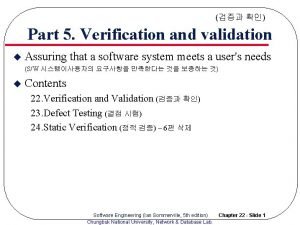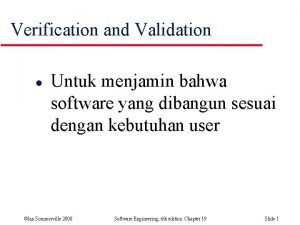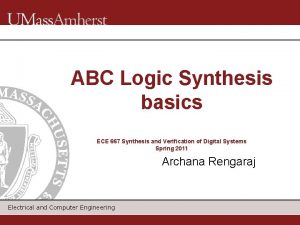ECE 667 Synthesis and Verification of Digital Circuits



























![Hu’s Algorithm: HLS - Scheduling Example (a=3) [©Gupta] 28 Hu’s Algorithm: HLS - Scheduling Example (a=3) [©Gupta] 28](https://slidetodoc.com/presentation_image_h/8be18859efb0a89092e34def96b8c72a/image-28.jpg)



![List Scheduling ML-RC – Example 1 (a=[2, 2]) Minimize latency under resource constraint (with List Scheduling ML-RC – Example 1 (a=[2, 2]) Minimize latency under resource constraint (with](https://slidetodoc.com/presentation_image_h/8be18859efb0a89092e34def96b8c72a/image-32.jpg)
![List Scheduling ML-RC – Example 2 a (a = [3, 1]) Minimize latency under List Scheduling ML-RC – Example 2 a (a = [3, 1]) Minimize latency under](https://slidetodoc.com/presentation_image_h/8be18859efb0a89092e34def96b8c72a/image-33.jpg)




- Slides: 37

ECE 667 Synthesis and Verification of Digital Circuits Scheduling Algorithms 1 HLS - Scheduling

Architectural Optimization • Optimization in view of design space flexibility • A multi-criteria optimization problem: – Determine schedule f and binding b. – Under area A, latency L and cycle time t objectives • Solution space tradeoff curves: – Non-linear, discontinuous – Area / latency / cycle time (more? ) • Evaluate (estimate) cost functions • Unconstrained optimization problems for resource dominated circuits: – Min area: solve for minimal binding – Min latency: solve for minimum L scheduling HLS - Scheduling 2

Scheduling, Allocation and Assignment Techniques are well understood and mature HLS - Scheduling Copyright 2003 Mani Srivastava 3

Scheduling and Assignment - Overview F 1 = (a + b + c) * d a b F 2 = (x + y) * z 4 control steps, 1 Add, 2 Mult Schedule 1 +1 s 1 Control Step c +2 s 2 d x *1 s 3 * * +3 s 3 w *2 s 4 HLS - Scheduling + y z F 1 F 3 = (x + y)* w F 2 *3 s 4 F 3 Copyright 2003 Mani Srivastava 4

Scheduling and Assignment - Overview F 1 = (a + b + c) * d Schedule 2 x F 2 = (x + y) * z y 4 control steps, 1 Add, 1 Mult +3 s 1 a b +1 s 2 c +2 s 3 d z *2 F 3 = (x + y)* w Control Step s 2 + * w *3 s 3 F 3 *1 s 4 F 1 HLS - Scheduling Copyright 2003 Mani Srivastava 5

Algorithm Description Data Flow Graph HLS - Scheduling 6

Data Flow Graph (DFG) HLS - Scheduling 7

Sequencing Graph Add source and sink nodes HLS - Scheduling 8

Sequencing Graph • Add source and sink nodes (NOP) to the DFG NOP * * * + + < Data Flow Graph (DFG) NOP HLS - Scheduling Sequencing Graph 9

ASAP Scheduling Algorithm • As Soon as Possible scheduling – – – Unconstrained minimum latency scheduling Uses topological sorting of the sequencing graph (polynomial time) Gives optimum solution to scheduling problem Schedule first the first node no T 1 until last node nv is scheduled Ci = completion time (delay) of predecessor i of node j HLS - Scheduling 10

ASAP Scheduling Algorithm - Example Assume Ci = 1 TS = 1 start TS = 2 TS = 3 TS = 4 HLS - Scheduling finish 11

ASAP Scheduling Example How many Add, Mult are needed ? Sequence Graph HLS - Scheduling ASAP Schedule 12

ALAP Scheduling Algorithm • As late as Possible scheduling – – – Latency-constrained scheduling (latency is fixed) Uses reversed topological sorting of the sequencing graph If over-constrained (latency too small), solution may not exist Schedule first the last node nv T, until first node n 0 is scheduled Ci = completion time (delay) of predecessor i of node j (Latency) HLS - Scheduling 13

ALAP Scheduling Algorithm - example Assume Ci = 1 TS = 1 finish TS = 2 TS = 3 TS = 4 = T HLS - Scheduling start 14

ALAP Scheduling Example NOP * 1 * 0 2 * 3 6 * 4 * 7 5 n * + 8 9 + < 10 11 NOP How many Add, Mult are needed ? Sequence Graph HLS - Scheduling ALAP Schedule (latency constraint = 4) 15

ASAP & ALAP Scheduling No Resource Constraint ASAP Schedule ALAP Schedule Slack Critical Path=4 Sequence Graph HLS - Scheduling 16

ASAP & ALAP Scheduling No Resource Constraint ASAP Schedule Having determined the minimum latency, what can we do with the slack? • Adds flexibility to the schedule • Determine the minimum # resources ALAP Schedule Slack What if you want to find • Min. latency given fixed resources? • Min resources given a latency? HLS - Scheduling 17

Computing Slack (mobility) • Slack of Operator i: Si = TSi. ALAP – TSi. ASAP S 6 = 2 -1 = 1 S 7 = 2 -1 = 1 S 8 = 3 -1 = 2 S 9 = 4 -2 = 2 S 10 = 3 -1 = 2 S 11 = 4 -2 = 2 – Defines mobility of the operators NOP * 1 * 2 * * 0 6 * 7 3 NOP + * 4 8 9 + < 10 * 1 11 * 2 * 3 * 4 5 NOP HLS - Scheduling * 6 7 5 n 0 n * + 8 9 + < 10 11 NOP 18

Timing Constraints • Time measured in cycles or control steps • Imposing relative timing constraints between operators i and j – max & min timing constraints Node number (name) HLS - Scheduling Required delay 19

Constraint Graph Gc(V, E) MULT delay =2 ADD delay = 1 HLS - Scheduling 20

Existence of Schedule under Timing Constraints • Upper bound (max timing constraint) is a problem • Examine each max timing constraint (i, j): – Longest weighted path between nodes i and j must be max timing constraint uij. – Any cycle in Gc including edge (i, j) must be negative or zero • Necessary and sufficient condition: – The constraint graph Gc must not have positive cycles • Example: – Assume delays: ADD=1, MULT=2 – Path {1 2} has weight 2 u 12=3, that is cycle {1, 2, 1} has weight = -1, OK – No positive cycles in the graph, so it has a consistent schedule HLS - Scheduling 21

Existence of schedule under timing constraints • Example: satisfying assignment – Assume delays: ADD=1, MULT=2 – Feasible assignment: Vertex Start time • • • v 0 step 1 v 1 step 1 v 2 step 3 v 3 step 1 v 4 step 4 vn step 5 HLS - Scheduling 22

Scheduling – a Combinatorial Optimization Problem • • • NP-complete Problem Optimal solutions for special cases and ILP Heuristics - iterative Improvements Heuristics – constructive Various versions of the problem • • Unconstrained, minimum latency Resource-constrained, minimum latency Timing-constrained, minimum latency Latency-constrained, minimum resource • If all resources are identical, problem is reduced to multiprocessor scheduling (Hu’s algorithm) HLS - Scheduling 23

Observation about ALAP & ASAP • No consideration given to resource constraints • No priority is given to nodes on critical path • As a result, less critical nodes may be scheduled ahead of critical nodes – No problem if unlimited hardware is available – However if the resources are limited, the less critical nodes may block the critical nodes and thus produce inferior schedules • List scheduling techniques overcome this problem by utilizing a more global node selection criterion HLS - Scheduling 24

Hu’s Algorithm • Simple case of the scheduling problem – Each operation has unit delay – Each operation can be implemented by the same operator (multiprocessor) • Hu’s algorithm – Greedy, polynomial time – Optimal for trees and single type operations – Computes minimum number of resources for a given latency (MR-LCS), or – computes minimum latency subject to resource constraints (ML-RCS) • Basic idea: – Label operations based on their distances from the sink – Try to schedule nodes with higher labels first (i. e. , most “critical” operations have priority) HLS - Scheduling 25

Hu’s Algorithm (for Multiprocessors) • Labeling of nodes – Label operations based on their distances from the sink • Notation – I = label of node i – = maxi i – p(j) = # vertices with label j • Theorem (Hu) Lower bound on the number of resources to complete schedule with latency L is amin = max j=1 p( +1 - j) / ( +L- ) where is a positive integer (1 +1) • In this case: amin= 3 (number of operators needed) HLS - Scheduling 26

Hu’s Algorithm (min Latency s. t. Resource Constraint) HU (G(V, E), a) { Label the vertices // a = resource constraint (scalar) // label = length of longest path passing through the vertex l=1 repeat { U = unscheduled vertices in V whose predecessors have been already scheduled (or have no predecessors) } Select S U such that |S| a and labels in S are maximal Schedule the S operations at step l by setting ti= l, vi S; l = l + 1; } until vn is scheduled. HLS - Scheduling 27
![Hus Algorithm HLS Scheduling Example a3 Gupta 28 Hu’s Algorithm: HLS - Scheduling Example (a=3) [©Gupta] 28](https://slidetodoc.com/presentation_image_h/8be18859efb0a89092e34def96b8c72a/image-28.jpg)
Hu’s Algorithm: HLS - Scheduling Example (a=3) [©Gupta] 28

List Scheduling (arbitrary operators) • Extend the idea to several operators • Greedy algorithm for ML-RCS and MR-LCS – Does NOT guarantee optimum solution • Similar to Hu’s algorithm – Operation selection decided by criticality – O(n) time complexity • Considers a more general case – Resource constraints with different resource types – Multi-cycle operations – Pipelined operations HLS - Scheduling 29

List Scheduling Algorithms • Algorithm 1: Minimize latency under resource constraint (ML-RC) – Resource constraint represented by vector a (indexed by resource type) • Example: two types of resources, MULT (a 1=1), ADD (a 2=2) • Algorithm 2: Minimize resources under latency constraint (MR-LC) – Latency constraint is given and resource constraint vector a to be minimized Define: • • • The candidate operations Ul, k – those operations of type k whose predecessors have already been scheduled early enough (completed at step l): Ul, k = { vi V: type(vi) = k and tj + dj l, for all j: (vj, vi) E The unfinished operations Tl, k – those operations of type k that started at earlier cycles but whose execution has not finished at step l (multi-cycle opearations): Tl, k = { vi V: type(vi) = k and ti + di > l Priority list – List operators according to some heuristic urgency measure – Common priority list: labeled by position on the longest path in decreasing order HLS - Scheduling 30

List Scheduling Algorithm 1: ML-RC Minimize latency under resource constraint LIST_L (G(V, E), a) { // resource constraints specified by vector a l=1 repeat { for each resource type k { Ul, k = candidate operations available in step l Tl, k = unfinished operations (in progress) Select Sk Ul, k such that |Sk| + |Tl, k| ak Schedule the Sk operations at step l } } l=l+1 } until vn is scheduled Note: If for all operators i, di = 1 (unit delay), the set Tl, k is empty HLS - Scheduling 31
![List Scheduling MLRC Example 1 a2 2 Minimize latency under resource constraint with List Scheduling ML-RC – Example 1 (a=[2, 2]) Minimize latency under resource constraint (with](https://slidetodoc.com/presentation_image_h/8be18859efb0a89092e34def96b8c72a/image-32.jpg)
List Scheduling ML-RC – Example 1 (a=[2, 2]) Minimize latency under resource constraint (with d = 1) • Assumptions – All operations have unit delay (di =1) – Resource constraints: MULT: a 1 = 2, ALU: a 2 = 2 • Step 1: – U 1, 1 = {v 1, v 2, v 6, v 8}, select {v 1, v 2} – U 1, 2 = {v 10}, select + schedule • Step 2: – U 2, 1 = {v 3, v 6, v 8}, select {v 3, v 6} – U 2, 2 = {v 11}, select + schedule • Step 3: – U 3, 1 = {v 7, v 8}, select + schedule – U 3, 2 = {v 4}, select + schedule • NOP Step 4: T 1 T 2 T 3 T 4 * 1 * 2 * 3 + * 4 * 5 6 < 7 * + – U 4, 2 = {v 5, v 9}, select + schedule NOP HLS - Scheduling 0 10 11 8 9 n 32
![List Scheduling MLRC Example 2 a a 3 1 Minimize latency under List Scheduling ML-RC – Example 2 a (a = [3, 1]) Minimize latency under](https://slidetodoc.com/presentation_image_h/8be18859efb0a89092e34def96b8c72a/image-33.jpg)
List Scheduling ML-RC – Example 2 a (a = [3, 1]) Minimize latency under resource constraint (with d 1=2, d 2=1 ) • Assumptions NOP – Operations have different delay: del. MULT = 2, del. ALU = 1 T 1 – Resource constraints: MULT: a 1 = 3, ALU: a 2 = 1 2 1 * 6 * * T 2 • MUTL U= {v 1, v 2, v 6} T= {v 1, v 2, v 6} U= {v 3, v 7, v 8} T= {v 3, v 7, v 8} ---Latency L = 8 HLS - Scheduling ALU v 10 v 11 --v 4 v 5 v 9 start time 1 2 3 4 5 6 7 T 3 * 10 < 11 8 7 3 + * * T 4 T 5 T 6 T 7 4 5 + NOP 9 n 33

List Scheduling ML-RC – Example 2 b (Pipelined) Minimize latency under resource constraint (a 1=3 MULTs, a 2=3 ALUs ) • Assumptions – Multipliers are pipelined – Sharing between first and second pipeline stage allowed for different multipliers • MULT {v 1, v 2, v 6} v 8 {v 3, v 7} ---- ALU v 10 v 11 -v 9 v 4 v 5 start time 1 2 3 4 5 6 NOP T 1 2 1 * 6 * * T 2 T 3 3 * * T 4 T 5 T 6 + 10 < 11 8 9 4 5 • L=7, Compare to multi-cycle case NOP HLS - Scheduling * 7 + n 34

List Scheduling Algorithm 2: MR-LC LIST_R (G(V, E), l’) { a = 1, l=1 Compute latest possible starting times t L using ALAP algorithm repeat { for each resource type k { Ul, k = candidate operations; Compute slacks { si = ti. L - l, vi Ul, k }; Schedule operations with zero slack, update a; Schedule additional Sk Ul, k requiring no additional resources; } l=l+1 } until vn is scheduled. } HLS - Scheduling 35

List Scheduling MR-LC – Example 4 (d ( i=1) Minimize resources under latency constraint • Assumptions – All operations have unit delay (di=1) – Latency constraint: L = 4 • Use slack information to guide the scheduling – Schedule operations with slack=0 first – Add other operations only if current resource count allows NOP T 1 T 2 • e. g. add *6 with *3, without exceeding current Mult=2 – The lower the slack the more urgent it is to schedule the operation T 3 T 4 * 1 * 2 * 3 + * 4 * 5 6 < 7 * + NOP HLS - Scheduling 0 10 11 8 9 n 36

Scheduling – a Combinatorial Optimization Problem • NP-complete Problem • Optimal solutions for special cases (trees) and ILP • Heuristics – iterative Improvements – constructive • Various versions of the problem • • Minimum latency, unconstrained (ASAP) Latency-constrained scheduling (ALAP) Minimum latency under resource constraints (ML-RC) Minimum resource schedule under latency constraint (MR-LC) • If all resources are identical, problem is reduced to multiprocessor scheduling (Hu’s algorithm) • Minimum latency multiprocessor problem is intractable for general graphs • For trees greedy algorithm gives optimum solution HLS - Scheduling 37
 Art 667
Art 667 Derechos asertivos básicos
Derechos asertivos básicos Power system analysis lecture notes
Power system analysis lecture notes 667
667 Current in a parallel circuit
Current in a parallel circuit Synthesis of synchronous sequential circuits
Synthesis of synchronous sequential circuits Verilog hdl a guide to digital design and synthesis
Verilog hdl a guide to digital design and synthesis Verilog hdl
Verilog hdl Digital integrated circuits a design perspective
Digital integrated circuits a design perspective Digital integrated circuits: a design perspective
Digital integrated circuits: a design perspective Digital circuits
Digital circuits Troubleshooting digital circuits
Troubleshooting digital circuits Digital integrated circuits a design perspective
Digital integrated circuits a design perspective State diagram of jk flip flop
State diagram of jk flip flop Digital integrated circuits
Digital integrated circuits Integrated circuit
Integrated circuit Characteristics of digital ic
Characteristics of digital ic E-commerce digital markets digital goods
E-commerce digital markets digital goods Euler
Euler Alexander hamilton
Alexander hamilton Parallel circuit
Parallel circuit Investigation in creative process
Investigation in creative process Verification and validation
Verification and validation Verification and validation
Verification and validation Testing types in software engineering
Testing types in software engineering Verification and validation plan
Verification and validation plan Verification principle strengths and weaknesses
Verification principle strengths and weaknesses Shelf rectification and stock verification
Shelf rectification and stock verification Verification and validation
Verification and validation Verification and validation
Verification and validation Verification and validation
Verification and validation Verification and validation plan
Verification and validation plan Verification and validation
Verification and validation Calibration verification material
Calibration verification material A software verification and validation method. section 19
A software verification and validation method. section 19 Software verification and validation plan
Software verification and validation plan Konsep warga digital
Konsep warga digital Digital data digital signals
Digital data digital signals





